|
|
Giovanni Pierluigi da Palestrina (Composer) |
|
Born: between February 3, 1525 and February 2, 1526 - probably Palestrina, near Rome, then part of the Papal States, Italy
Died: February 2, 1594 - Rome, Italy |
|
Giovanni Pierluigi da Palestrina was an Italian composer of the Renaissance. He was the most famous 16th century representative of the Roman School of musical composition. Palestrina had a vast influence on the development of Roman Catholic church music, and his work can be seen as a summation of Renaissance polyphony. |
|
Life |
|
Giovanni Pierluigi da Palestrina was born in Palestrina, a town near Rome, then part of the Papal States. He spent most of his career in Rome. Documents suggest he first visited the city in 1537, when he is listed as a chorister at Santa Maria Maggiore basilica. He studied with Robin Mallapert and Firmin Lebel. It was rumored Palestrina studied under Claude Goudimel; the story originated in the 19th century, but according to recent study, Goudimel was never in Rome.
From 1544 to 1551 Palestrina was organist of the principal church of his native city (St Agapito), and in the last year became maestro di cappella at the Cappella Giulia, the papal choir at St. Peter's Basilica. His first published compositions, a book of masses made so favorable an impression with Pope Julius III (previously the Bishop of Palestrina), that he was appointed musical director of the Julian Chapel. In addition, this was the first book of masses by a native composer: in the Italian states of his day, most composers of sacred music were from Netherlands, France, Portugal or Spain. In fact his book of masses was actually modeled on one by Morales, and the woodcut in the front is an almost exact copy of the one from the book by the Spaniard.
Palestrina held positions similar to his Julian Chapel appointment at other chapels and churches in Rome during the next decade (notably St John in Lateran, from 1555 to 1560, and St Maria Maggiore, from 1561-1566). In 1571 he returned to the Julian Chapel, and remained at St Peter's for the rest of his life. The decade of the 1570s was difficult for him personally; he lost his brother, two of his sons, and his wife in three separate outbreaks of the plague (1572, 1575, and 1580 respectively). He seems to have considered becoming a priest at this time, but instead he married again, this time to a wealthy widow; this finally gave him financial independence (he was not well paid as choirmaster) and he was able to compose prolifically until his death. He died in Rome of pleurisy in 1594. |
|
Music and Reputation |
|
See: List of compositions by Giovanni Pierluigi da Palestrina (Wikipedia) |
|
Palestrina left hundreds of compositions, including 104 masses, 68 offertories, more than 300 motets, at least 72 hymns, 35 magnificats, 11 litanies, 4 or 5 sets of lamentations etc., at least 140 madrigals and 9 organ ricercari (however, recent scholarship has classed these ricercai as of doubtful authorship; Palestrina probably wrote no purely instrumental music). There are two comprehensive editions of Palestrina's works: one edited by Haberl and published in 33 volumes in 1862-1894, the other edited by R. Casimiri and others and published in 34 volumes. His Missa sine nomine seems to have been particularly attractive to J.S. Bach, who studied and performed it while he was writing his own masterpiece, the Mass in B Minor (BWV 232). His compositions are typified as very clear, with voice parts well-balanced and beautifully harmonized. Among the works counted as his masterpieces is the Missa Papae Marcelli (Pope Marcellus Mass), which according to legend was composed to persuade the Council of Trent that a draconian ban on polyphonic treatment of text in sacred music was unnecessary. However, more recent scholarship shows that this mass was composed before the cardinals convened to discuss the ban (possibly as much as ten years before). It is probable, however, that Palestrina was quite conscious of the needs of intelligible text in conformity with the doctrine of the Counter-Reformation, and wrote his works towards this end from the 1560s until the end of his life.
The "Palestrina Style" - the smooth style of 16th century polyphony, derived and codified by Johann Joseph Fux from a careful study of his works - is the style usually taught as "Renaissance polyphony" in college counterpoint classes, although in a modified form, as J.J. Fux made a number of stylistic errors which have been corrected by later authors (notably Knud Jeppesen and Morris). As codified by J.J. Fux it follows the rules of what he defined as "species counterpoint." Palestrina established and followed these strict guidelines:
- The flow of music is dynamic, not rigid or static.
- Melody should contain few leaps between notes.
- If a leap occurs, it must be small and immediately countered by opposite stepwise motion.
- Dissonances are either passing note or off the beat. If it is on the beat, it is immediately resolved.
No composer of the 16th century was more consistent in following his own rules, and staying within the stylistic bounds he imposed on himself, than was Palestrina. Also, no composer of the 16th century has had such an edifice of myth and legend built around him. Much of the research on Palestrina was done in the 19th century by Giuseppe Baini, who published a monograph in 1828 which made Palestrina famous again, and reinforced the already existing legend that he was the "Saviour of Church Music" during the reforms of the Council of Trent. The nineteenth-century attitude of hero-worship is predominant in this monograph, however, and this has remained with the composer to some degree to the present day; Hans Pfitzner's opera Palestrina shows this attitude at its peak. Scholarship of the 20th and 21st centuries tends to retain the view that Palestrina was a strong and refined composer, representing a summit of technical perfection, but emphasizes that there were other composers working at the same time with equally individual voices and slightly different styles, even within the confines of smooth polyphony, such as Lassus and Victoria.
Palestrina was immensely famous in his day, and his reputation, if anything, increased following his death. Conservative music of the Roman School continued to be written in his style (known as the "prima pratica" in the 17th century), by such students of his as Giovanni Maria Nanino, Ruggiero Giovanelli, Arcangelo Crivelli, Teofilo Gargari, Francesco Soriano and Gregorio Allegri. It is also thought that Salvatore Sacco may have been a student of Palestrina. Palestrina's music continues to be performed and recorded, and provides models for the study of counterpoint. |
|
J.S. Bach Connection |
|
Among the compositions by other composers that J.S. Bach became involved with, Palestrina's Missa sine nomine occupies a special place, since J.S. Bach's reworking of it exemplifies a process which was becoming widespread in Germany. For example, Johann Gottlob Harrer, J.S. Bach's successor as Thomaskantor in Leipzig, had already furnished the same mass with parts for two oboes, three violins, two violas, bass, and continuo (harpsichord and organ). In his youth J.G. Harrer had travelled to Italy at the expense of his protector, Count Heinrich von Briihl, and had brought to Dresden a considerable number of sacred works by Italian masters, Palestrina in particular; the Missa sine nomine was one of at least six Palestrina masses that J.G. Harrer 'restyled'.
J.S. Bach's involvement with the work, which first appeared in the Missarum liber quintus pubin Rome by Francesco Coattino in 1590, is datable to about 1742-1745. He provided colla parte instrumentation for two cornetts, four trombones, organ, harpsichord, and violone. Only the last three parts are autograph in the Berlin source, the others being in the hand of the so-called Hauptkopist I. It is particularly significant that J.S. Bach provided instrumental accompaniment only for the Kyrie and Gloria, the two sections constituting the MISSA in the Lutheran liturgy of the time, and it is reasonable to assume that only these sections were performed under J.S. Bach's direction. It is nevertheless logical to conclude that the other sections of Palestrina's mass were copied with the precise intention of showing the musicians active in the J.S. Bach circle the importance of the stile antico. |
|
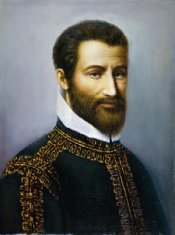

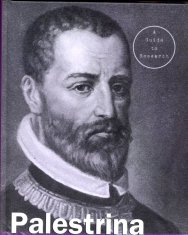
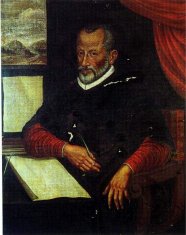
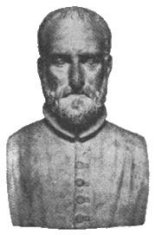
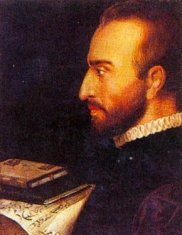
|
|
More Pictures |
|
Source: Wikipedia Website (based on Lewis Lockwood, Noel O'Regan, Jessie Ann Owens: "Palestrina, Giovanni Pierluigi da" in Grove Music Online, ed. L. Macy; aAccessed July 7, 2007); )Malcom Boyd, editor: Oxford Composer Companion J.S. Bach (Oxford University Press, 1999, Article author: Alberto Basso)
Contributed by Aryeh Oron (November 2008) |
|
Giovanni Pierluigi da Palestrina : Short Biography | Missa sine nomine a 6 | Missa Ecce sacerdos | Palestrina & Bach - Discussions |
|
Works arranged / performed by J.S. Bach |
|
Missa sine nomine a 6 SSATTB - in Kyrie, Gloria J.S. Bach added 2 cornetts, 4 trombones, organ, harpsichord, and violone; performed by J.S. Bach in Leipzig c1742 (C. Wolff) or c1742-1745 (OCC)
Missa sopra la Cantilena Ecce Sacerdos Magnus a 4 [Source: Barbara Wiermann, ‘Bach und Palestrina - Neue Quellen aus Johann Sebastian Bachs Notenbibliothek’, Bach-Jahrbuch (2002), 9-25.] |
|
Links to other Sites |
|
Giovanni Pierluigi da Palestrina's Foundation [Italian/English]
Giovanni Pierluigi da Palestrina (Wikipedia)
Giovanni Pierluigi da Palestrina (Classical Music Pages)
Catholic Encyclopedia: Giovanni Pierluigi da Palestrina
HOASM: Giovanni Pierluigi Da Palestrina
Classical Music Archives: Palestrina
Giovanni Pierluigi da Palestrina (Berkeley) |
Palestrina (Rome Art Lover)
Palestrina biography (8 Notes)
Giovanni Pierluigi da Palestrina Biography (Naxos)
Palestrina, Giovanni Pierluigi da: Biography (Sojurn)
Giovanni Pierluigi Da Palestrina, Biography(Goldberg)
Giovanni Pierluigi da Palestrina (Britannica Encyclopedia) |
|
Bibliography |
|
Article "Palestrina, Giovanni Pierluigi da", in: The New Grove Dictionary of Music and Musicians, ed. Stanley Sadie. 20 vol. (London, Macmillan Publishers Ltd., 1980)
Thomas Benjamin: The Craft of Modal Counterpoint, 2nd ed. (Routledge, New York, 2005)
Henry Coates: Palestrina (J.M. Dent & Sons, London, 1938)
Thomas Daniel: Kontrapunkt, Eine Satzlehre zur Vokalpolyphonie des 16. Jahrhunderts (Verlag Dohr, 2002)
Johann Joseph Fux: The Study of Counterpoint (Gradus ad Parnassum). Tr. Alfred Mann (W.W. Norton & Co., New York, 1965)
Robert Gauldin: A Practical Approach to Sixteenth-Century Counterpoint (Waveland Press, Inc., Long Grove, Illinois, 1995)
Andrew C. Haigh: "Modal Harmony in the Music of Palestrina", in the festschrift Essays on Music: In Honor of Archibald Thompson Davison (Harvard University Press, 1957), pp.111-120
Knud Jeppesen: The Style of Palestrina and the Dissonance. 2nd ed. (London, 1946)
Knud Jeppesen; Glen Haydon (Translator); Foreword by Alfred Mann: Counterpoint (New York, 1939)
Bernhard Meier:The Modes of Classical Vocal Polyphony, Described According to the Sources (Broude Brothers Limited, 1988)
R.O. Morris: Contrapuntal Technique in the Sixteenth Century (Oxford University Press, 1978)
Diether de la Motte: Kontrapunkt (1981 Bärenreiter-Verlag, Kassel)
Zoe Kendrick Pyne: Giovanni Pierluigi di Palestrina: His Life and Times (Bodley Head, London, 1922)
Gustave Reese: Music in the Renaissance (W.W. Norton & Co., New York, 1954)
Jerome Roche: Palestrina (Oxford University Press, 1970)
Robert Stewart: An Introduction to Sixteenth-Century Counterpoint and Palestrina's Musical Style (Ardsley House, Publishers, 1994)
R. J. Stove: Prince of Music: Palestrina and His World (Quakers Hill Press, Sydney, 1990)
Owen Swindale: Polyphonic Composition (Oxford University Press, 1962)
Alberto Basso: 'Bach e Palestrina', in L. Bianchi and G. Rostirolla, editors: Atti del II Convegno Internazionale di Studi Palestrilliani (Palestrina, 1991), pp. 409-419
G. FelIerer: 'J. S. Bachs Bearbeitung der "Missa sine nomine" von Palestrina', BJb 24 (1927), pp. 123-132
A. Schering: 'Der Thomaskantor Joh. Gottlob Harrer (1703-1755)', BJb 28 (1931), pp. 112-46
Christoph Wolff: Der stile antico ill der Musik Johann Sebastian Bachs (Wiesbaden, 1968)
Christoph Wolff: “Bach and the Tradition of the Palestrina Style,” in Bach: Essays on His Life and Music, 1991, pp. 84-101 |
|
|